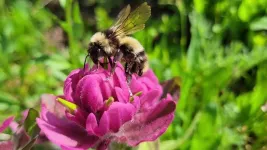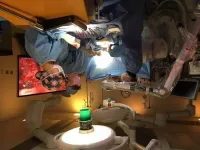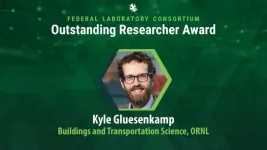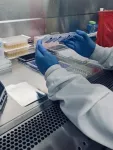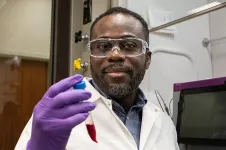(Press-News.org) UNSW medical researcher Dr David Jacques and his team have discovered how the human immunodeficiency virus (HIV) breaches the cell nucleus to establish infection, a finding that has implications beyond HIV biology.
To infect cells, HIV must enter the target cell and make its way to the nucleus in the cell’s centre where enough copies of its genetic code can be produced to infect other cells.
To safely complete this quest, the virus builds a protective protein coat – a capsid – to shield itself from the host’s immune defences geared to destroy it. Until now, it has remained a mystery exactly how the entire capsid moves through the pores embedded in the nuclear envelope to enter the nucleus.
But the research published in Nature today reveals just how the HIV capsid gets into the nuclear pore barrier channel.
Restricted access
“The nuclear pore complex is made up of a combination of proteins,” said the study’s senior author Dr Jacques of UNSW’s School of Biomedical Sciences.
“While small molecules pass in and out of the nucleus via the nuclear pore complex, traffic is restricted for bulky cargo.
“Larger proteins need to be bound to nuclear transporters – chaperone proteins – that carry them through the multi-layered molecular gate.”
The HIV capsid, despite being a thousand times bigger than the size of molecules that filter through the barrier layers, could pass into the nuclear transport channels without chaperones, Dr Jacques’ team showed.
Chaperone proteins – also called ‘karyopherins’ – engage with the proteins in the middle of the nuclear pore complex in a way that allows them to move with their payload into each successive layer of the molecular gate. Bulky structures without chaperones are excluded from this portal because they are unable to connect with the gate-keeper proteins in the nuclear pore.
HIV using ‘secret handshake’ to get in
The HIV capsid, however, has evolved to interact with the barrier proteins in the same way as the host’s chaperone proteins.
“One of the theories in the field is that HIV hijacks a host chaperone to gain access to the nucleus. But our results show that HIV does not need a chaperone because it is its own chaperone. It’s as though the viral capsid has learned the secret handshake to be permitted into a restricted area by mimicking the chaperones,” Dr Jacques said.
“People made assumptions about how the capsid might get past the selective barrier. Our work is really starting to directly address this, and to me that’s exciting,” said Dr Claire Dickson, co-first author of the study.
The discoveries were enabled by a single-molecule method developed previously by the team that allowed them to systematically screen proteins of the nuclear pore complex to identify those that interacted with the intact HIV capsid.
Dr Jacques is particularly excited about bringing together the collective knowhow of his multidisciplinary team in Australia and the UK, and the crucial infrastructure available at UNSW.
“The only way we were able to deliver this project was by tapping into UNSW’s Mark Wainwright Analytical Centre and the expertise that they brought across the breadth of different technologies and methods that we needed, including protein production, structural biology, super-resolution imaging and electron microscopy,” he said.
“I am really proud of being able to overcome some major challenges with this project, to make a significant impact on the field of HIV research by aiding a better understanding of this process,” said co-first author Dr Sophie Hertel.
Wider implications
The molecular understanding gained in this study about host-pathogen interactions, the authors believe, goes beyond uncovering details of the lifecycle of HIV. This mechanistic knowledge can also be exploited for other applications including gene therapy.
“HIV is one of the most studied pathogens, but we still have so much that we can learn from it. There’s something special about HIV; it can penetrate the nucleus without damaging it or needing to wait for the cell to divide like other viruses. Our observations give us insight that allows us to think about how we deliver cargo into the nucleus,” said Dr Jacques.
END
How does HIV get into the cell’s centre to kickstart infection?
2024-01-24
ELSE PRESS RELEASES FROM THIS DATE:
One in five Colorado bumblebees are endangered, new report says
2024-01-24
On a cliffside at Mesa Verde National Park in southern Colorado, a fuzzy bee was industriously gnawing at the red sandstone. Making a loud grinding sound, the insect used its powerful jaws to drill tunnels and holes in rocks, where it would build a nest for raising offspring.
The bee, known as Anthophora pueblo, is a type of digger bee native to Colorado. Discovered less than a decade ago, the bee has quickly become Adrian Carper’s favorite pollinator.
“This is just one example of how crazily diverse our native bees are,” said Carper, an ...
Mayo Clinic study explores heart failure, uncovers gene’s role in recovery
2024-01-24
Mayo Clinic researchers studying the genetics of people who had recently developed dilated cardiomyopathy, one of the most common causes of heart failure, have found a particular gene to target for developing future drug therapy treatments. The disease makes it harder for the heart's left ventricle to pump blood effectively to the rest of the body. In this first genome-wide association study, the researchers sought to understand why some patients get better after developing the condition — and some don't.
"We found genetic variation in the CDCP1 gene, a gene that no one has heard of in ...
How studying defensive bacteria may help human gut health
2024-01-24
MSU has a satellite uplink/LTN TV studio and Comrex line for radio interviews upon request.
Images
EAST LANSING, Mich. – Thousands of types of bacteria live in the human gut. They help digest the food we eat and absorb nutrients, but these bacteria don’t just do this to be kind to humans, there is a benefit for them too.
Elizabeth Heath-Heckman, an assistant professor in the College of Natural Science, has received a five-year National Institutes of Health grant from the National Institute for General Medical Sciences totaling $1.9 million to support her research studying ...
Study: This protein may be the ‘glue’ that helps COVID virus stick
2024-01-24
When SARS-CoV-2 enters the human body, the virus’ spike protein binds to a cell, allowing the virus to infiltrate and begin replicating.
A new study from Tulane University, conducted in partnership with Florida International University and published in Protein Science, has identified a protein that may be the glue that helps COVID’s spike protein stick.
The study found that a small piece of a proteoglycan called perlecan LG3 – a protein most commonly found in blood vessels and the brain – ...
Can we predict when a migraine attack will occur?
2024-01-24
EMBARGOED FOR RELEASE UNTIL 4 P.M. ET, WEDNESDAY, JANUARY 24, 2024
MINNEAPOLIS – Migraine is often underdiagnosed and untreated, and even when it is treated, it can be difficult to treat early enough as well as find strategies to prevent attacks. A new study looks at ways to more accurately predict when a migraine will occur—through the use of mobile apps to track sleep, energy, emotions and stress—to enhance the ability to prevent attacks. The study is published in the January 24, 2024, online issue of Neurology®, the medical journal of ...
Researchers suggest changing gold standard of spine surgery from operative microscope to 3D exoscope
2024-01-24
While surgeons have more commonly used the exoscope in various intracranial procedures, its use in spinal surgery has been underreported.
Researchers and neurosurgeons at the Medical University of South Carolina (MUSC) retrospectively compared the operative microscope to the 3D exoscope in a recent study published in World Neurosurgery and found better outcomes among both surgeons and patients when using the exoscope.
Stephen Kalhorn, M.D., FAANS, was the principal investigator on the study, and he says the traditional operative microscope has ...
ORNL wins five Federal Laboratory Consortium awards
2024-01-24
Researchers, staff members and licensees from the Department of Energy’s Oak Ridge National Laboratory received top honors in the Federal Laboratory Consortium’s annual awards competition for excellence in technology transfer, excellence in technology transfer innovation, outstanding researcher and regional technology transfer.
The Federal Laboratory Consortium, or FLC, recently announced 32 award winners, ORNL included, for contributions to technology transfer, which turns cutting-edge research into impactful products and services. The FLC represents more than 300 federal laboratories, agencies and research centers ...
Foodborne-pathogen Listeria may hide from sanitizers in biofilms
2024-01-24
UNIVERSITY PARK, Pa. — An estimated 1,600 people in the U.S. contract a serious infection from Listeria bacteria in food each year and, of those individuals, about 260 people die, according to the Centers for Disease Control and Prevention. Penn State researchers may now better understand how the bacteria, called Listeria monocytogenes, survive and persist in fruit-packing plants by evading and surviving sanitizers.
According to their study, which is now available online and will be published in the June issue of the journal Biofilm, biofilms — comprising otherwise harmless microorganisms that attach to each ...
Purdue Innovates awards Purdue researchers $150K to develop innovations for the marketplace
2024-01-24
WEST LAFAYETTE, Ind. – Four researchers in Purdue University’s colleges of Engineering and Science, the Purdue Institute for Cancer Research and the Purdue Institute for Drug Discovery have received a total of $150,000 from the Trask Innovation Fund to strengthen the appeal of their patent-pending intellectual property for commercial use.
The fund is managed by the Purdue Innovates Incubator, which provides programming for the Purdue University community to ideate, refine and support their solutions. The fund awards up to $50,000 for short-term projects that enhance the commercial value of Purdue intellectual ...
JMIR Bioinformatics and Biotechnology invites submissions for research papers on machine learning-driven genomic predictive models
2024-01-24
JMIR Publications is pleased to announce a new theme issue titled “Machine Learning-Based Predictive Models Using Genomic Data” in JMIR Bioinformatics and Biotechnology. The peer-reviewed journal is indexed in SCOPUS and focused on research in bioinformatics, computational biology, and biotechnology. This new theme issue aims to explore cutting-edge research at the intersection of machine learning and genomics, fostering advancements in predictive modeling for biological insights.
JMIR Bioinformatics and Biotechnology welcomes contributions from global researchers, educators, and practitioners. We encourage submissions exploring diverse aspects of bioinformatics ...
